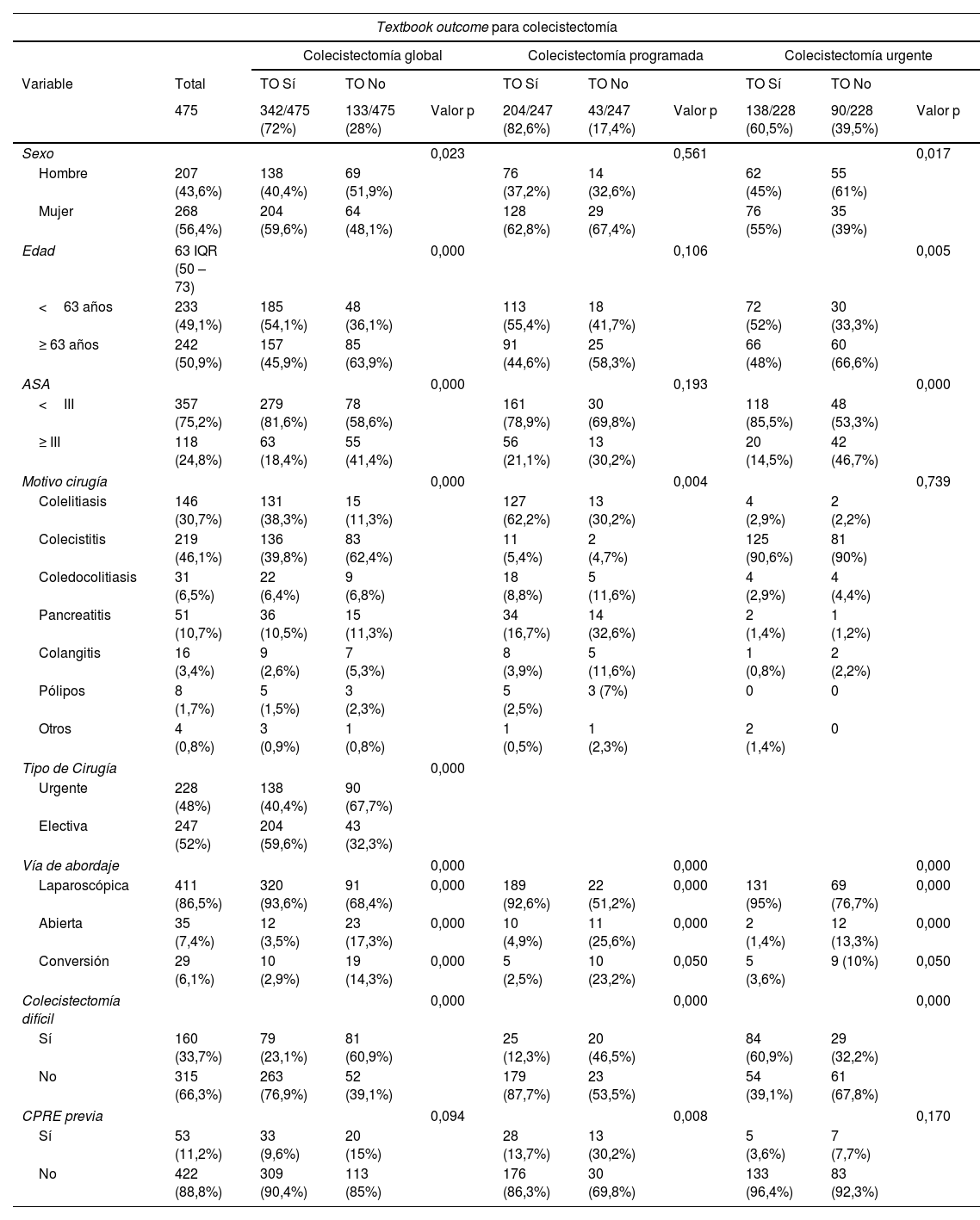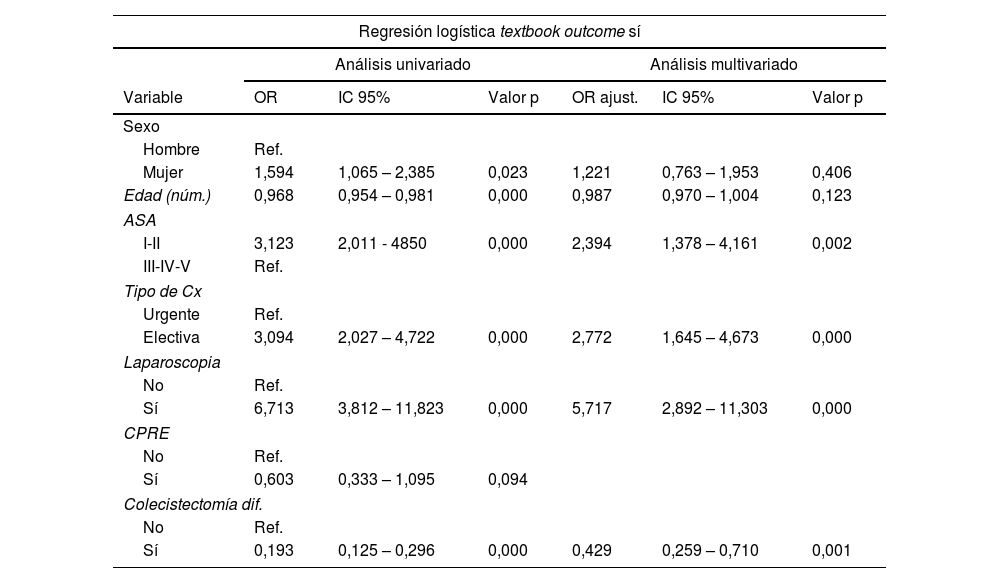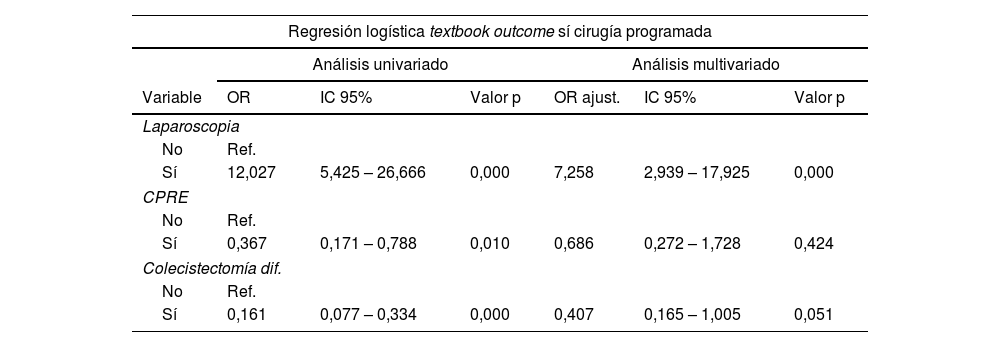La colelitiasis es el diagnóstico hospitalario más común del sistema digestivo, y su tratamiento, si es sintomática, es la colecistectomía laparoscópica. Existe una necesidad creciente de una determinación exhaustiva de los resultados posoperatorios y la eficiencia de los centros sanitarios. El textbook outome (TO) es un indicador de calidad asistencial utilizado habitualmente en procedimientos oncológicos, obtenido al sumar varios parámetros posoperatorios, que informa si se ha obtenido un resultado perfecto. El objetivo principal de este estudio es determinar el TO para colecistectomía, y ver los factores que influyen en su consecución.
MétodosEstudio observacional unicéntrico de cohorte retrospectivo sobre pacientes intervenidos de colecistectomía entre 2018 y 2020. Definimos TO como aquellos pacientes que cumplieron las siguientes premisas: complicaciones Clavien-Dindo<III, estancia posquirúrgica menor del percentil 75 (< 3 días), y no reingresos ni mortalidad en los primeros 90 días. Se analizaron las características perioperatorias, dividiendo los pacientes en dos grupos según la consecución o no de TO. Definimos unos criterios de colecistectomía difícil según el informe operatorio.
ResultadosEl porcentaje de TO global fue de 72% (342/475) (82,6% en cirugía programada y 60,5% en cirugía urgente). El análisis univariante demostró que los siguientes factores se asocian a la consecución de TO: sexo femenino, edad <63 años, riesgo según la Asociación Americana de Anestesiología (ASA) <III, cirugía electiva, abordaje laparoscópico y no ser colecistectomía difícil. Tras el análisis multivariante se mantiene significativo el riesgo ASA <III (odds ratio [OR] 2,39 IC 95% 1,37–4,16), la cirugía electiva (OR 2,77 IC 95% 1,64-4,67), el abordaje laparoscópico (OR 5,71 IC 95% 2,89-11,30) y no ser colecistectomía difícil (OR 0,42 IC 95% 0,259-0,71).
ConclusionesEl TO es una herramienta de calidad asistencial sencilla de realizar, fácilmente interpretable y útil para evaluar la calidad en la atención sanitaria y comparar centros, aplicable no solo en procedimientos oncológicos, sino también en la colecistectomía.
Cholelithiasis is the most common hospital diagnosis of the digestive system, and its treatment, if symptomatic, is laparoscopic cholecystectomy. There is a growing need for comprehensive determination of postoperative outcomes and the efficiency of healthcare facilities. The “textbook outcome”(TO) indicates the quality of care commonly used in oncological procedures, obtained by adding several postoperative parameters, which informs whether a perfect result has been obtained. The main objective of this study is to determine the TO for cholecystectomy and to see the factors that influence its achievement.
MethodsRetrospective observational unicentric cohort study on patients who underwent cholecystectomy between 2018-2020. We defined TO as those patients who met the following premises: Clavien-Dindo complications <III, postsurgical stay less than the 75th percentile (<3 days), and no readmissions or mortality in the first ninety days. Perioperative characteristics were analyzed, and the patients were divided into two groups according to whether or not they achieved TO. We defined criteria for difficult cholecystectomy according to the operative report.
ResultsThe percentage of TO was 72% (342/475) (82.6% in elective surgery and 60.5% in urgent surgery). The univariate analysis showed that the following factors are associated with achieving TO: female sex, age <63 years, ASA risk <III, elective surgery, laparoscopic approach, and not difficult cholecystectomy. After multivariate analysis, ASA<III (OR 2.39 CI95% 1.37-4.16), elective surgery (OR 2.77 CI95% 1.64-4.67), laparoscopic approach (OR 5.71 CI95% 2.89-11.30) and not to be difficult cholecystectomy (OR 0.42 CI95% 0.259-0.71) remained statistically significant.
ConclusionsThe TO is a healthcare quality tool that is simple to perform, easily interpretable, and helpful for evaluating quality in healthcare and comparing centers. It applies not only to oncological procedures but also to cholecystectomy.













